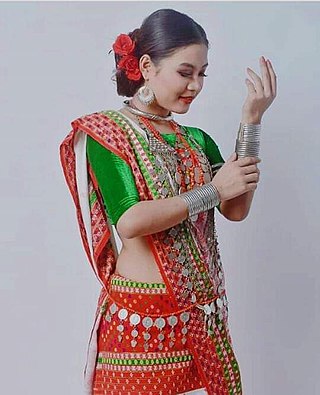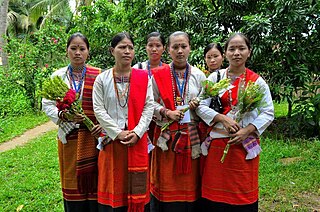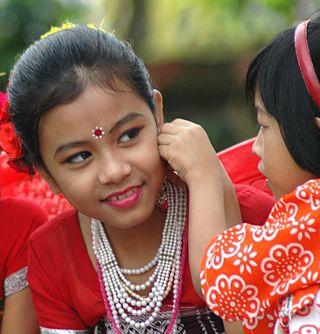Related Research Articles

Dhol can refer to any one of a number of similar types of double-headed drum widely used, with regional variations, throughout the Indian subcontinent. Its range of distribution in Indian subcontinent primarily includes northern areas such as the Jammu, Himachal, Punjab, Haryana, Delhi, Kashmir, Sindh, Assam Valley, Uttarakhand, West Bengal, Odisha, Gujarat, Maharashtra, Konkan, Goa, Karnataka, Rajasthan, Bihar, Jharkhand and Uttar Pradesh. A related instrument is the dholak or dholki. Dhols are amongst other events used in Indian wedding ceremony processions such as Baraat or Varyatra.

Tripura is a state in Northeast India. The third-smallest state in the country, it covers 10,491 km2 (4,051 sq mi); and the seventh-least populous state with a population of 3.67 million. It is bordered by Assam and Mizoram to the east and by Bangladesh to the north, south and west. Tripura is divided into 8 districts and 23 sub-divisions, where Agartala is the capital and the largest city in the state. Tripura has 19 different tribal communities with a majority Bengali population. Bengali, English and Kokborok are the state's official languages.

Makar(a) Sankranti, also referred to as Uttarayana, Makar, or simply Sankranti, is a Hindu observance and a festival. Usually falling on the date of 14 January annually, this occasion marks the transition of the sun from the zodiac of Sagittarius (dhanu) to Capricorn (makara). Since the sun has made this transition which vaguely coincides with moving from south to north, the festival is dedicated to the solar deity, Surya, and is observed to mark a new beginning. Many native multi-day festivals are organised on this occasion all over India.

Pohela Boishakh is the first day of the Bengali calendar which is also the official calendar of Bangladesh. This festival is celebrated on 14 April in Bangladesh and 15 April in the Indian states of West Bengal, Tripura, Jharkhand and Assam by Bengalis regardless of religious faith.

The Chakma people, are an ethnic group from the eastern-most regions of the Indian subcontinent. They are the largest ethnic group in the Chittagong Hill Tracts region of southeastern Bangladesh, and the second-largest in Mizoram, India. Significant Chakma populations are found in the northeast Indian states of Arunachal Pradesh, Tripura and Assam.

The Marma, also known as Moghs, Mogs or Maghs, are the second-largest ethnic community in Bangladesh's Chittagong Hill Tracts, primarily residing in the Bandarban, Khagrachari and Rangamati Hill Districts. They belong to the same community as the Rakhine people. Many Marmas live in Bangladesh's coastal districts of Cox's Bazar and Patuakhali, while few of them live in Tripura, India and Myanmar. There are about 224,261 Marmas living in Bangladesh and 35,722 of them living in India. Since the 16th century, the Marma have considered the Bengal's Chittagong Hill Tracts their home, where they have established the Bohmong and Mong Circles (chiefdoms).

The culture of Bangladesh is intertwined with the culture of the Bengal region of the Indian subcontinent. It has evolved over the centuries and encompasses the cultural diversity of several social groups of Bangladesh. The Bengal Renaissance of the 18th early 19th centuries, noted Bengali writers, saints, authors, scientists, researchers, thinkers, music composers, painters, film-makers have played a significant role in the development of Bengali culture. The culture of Bangladesh is deeply intertwined with the culture of the Bengal region. Basically Bengali culture refers to the culture of Bangladesh. The Bengal Renaissance contained the seeds of a nascent political Indian nationalism which was the precursor in many ways to modern Indian artistic cultural expression.

The Tripuri, are a Tibeto-Burman-speaking ethnic group of Northeast Indian state of Tripura. They are the descendants of the inhabitants of the Twipra/Tripura Kingdom in North-East India and Bangladesh. The Tripuri people through the Manikya dynasty ruled the Kingdom of Tripura for ~450 years until the kingdom joined the Indian Union on 15 October 1949.
The Dances of Tripura refer to several forms of folk dance performed in the state of Tripura in northeastern India. These dances are performed by the Tripuri and Mog peoples, during annual regional celebrations, such as sowing and harvesting festivals.
The indigenous people of Bangladesh are ethnic minorities in Chittagong Hill Tracts (southeastern), Sylhet Division (northeastern), Rajshahi Division (west), and Mymensingh Division (north-central) areas of the country. They are indigenous and the tribal races, total population of ethnic minorities in Bangladesh was estimated to be over 2 million in 2010. They are diverse ethnic communities including Tibeto-Burman, Austric and Dravidian people.

The Tanchangya people or Tanchangyas are an indigenous ethnic group living in the Chittagong Hill Tracts (CHT) of Bangladesh, Indian states of Tripura and Mizoram, and Rakhine state of Myanmar.

The culture of Tripura is distinct and a bit similar to other people of Northeast India. However like Assam, Manipur, Burma and Southeast Asia culture of Tripura is characterized in small portion where people live in plain and hill areas. Tripura is a state in North East India. In the 2001 census of India, Bengalis represented almost 70% of the population and the Tripuri population comprised 30% of Tripura's population. The Tripuri population comprises some clans and ethnic groups with diverse languages and cultures. The largest native group was the Tripuri who had a population of 543,848 in 2001 census, representing 16.99% of the state population and 54.7% of the scheduled tribe population. The other group of people in order of decreasing population were Chakma (6.5%), Halam (4.8%), Mog (3.1%), Munda, Kuki tribes and Garo Hajong. Bengali is the most spoken language, due to the dominance of Bengali people in the state. Kokborok (Tripuri/Tiprakok) is a common language among Tripuris and lingua franca in Tripura. Several other languages belonging to Indo-European and Sino-Tibetan families are spoken by the different tribe

Danda Naata or Danda Jatra is one of the most important traditional dance festivals organized in different parts of South Odisha and particularly in the Ganjam District, the heartland of ancient Kalinga Empire. The Danda Naata festival is being held in the month of Chaitra of every year. As per Ram Prasad Tripathy's article, it is an ancient festival of the Kalinga kingdom and still alive in and around the ancient Kalinga capital Sampa or Samapa i.e modern day Jaugada of Ganjam district. The Participants of Danda are called Danduas and they pray Goddesses Kali and Shiva during this 13-, 18- or 21-day Danda period.

Pana Sankranti,, also known as Maha Bishuba Sankranti, is the traditional new year day festival of Odia people in Odisha, India. The festival occurs in the solar Odia calendar on the first day of the traditional solar month of Meṣa, hence equivalent lunar month Baisakha. This falls on the Purnimanta system of the Indian Hindu calendar. It therefore falls on 13/14 April every year on the Gregorian calendar.
Several folk dance forms evolved in different regions of Odisha, Odissi and Chhau being some popular forms. Sambalpuri dance is most popular dance of western Odisha and is enjoyed by many.

Folk dances of Assam include the Bihu and the Bagurumba, the Bhortal, the Ojapali dance. Assam is home to many groups: Muslim, Indo-Aryan, Rabha, Bodo, Dimasa, Karbi, Mising, Sonowal Kacharis, Mishmi and Tiwa (Lalung) etc. These cultures come together to create an Assamese culture. Residents of the state of Assam are known as "Axomiya" (Assamese). Most tribes have their own language, although Assamese is the primary language of the state.
Tirhuta Panchang is a calendar followed by the Maithili community of India and Nepal. This calendar is one of the many Hindu calendars. It is a tropical solar Hindu calendar in which the year begins on the first day of Baishakh month i.e. Mesh Sankranti. Every year, this day falls on 13/14 April of the Gregorian Calendar
The traditional New Year in many South and Southeast Asian cultures is based on the sun's entry into the constellation Aries. In modern times, it is usually reckoned around 14 April.

Folk music is one of the genres of music in Bangladesh. It is mainly Bengali's own music. This music talks about the lives of the people of rural Bengal, happiness, and sorrow. There are many parts to it again. It highlights the culture of a country or any region of the country.

Sangrai is the name of the New Year celebration of the Bangladeshi Marma and Rakhine ethnic groups, which is celebrated from April 13 to 15 every year. Although it is one of the main traditional ceremonies of the Marmas, the Rakhine also celebrate the New Year with their own rules. In the case of the Marmas, it is celebrated according to their Burmese calendar. The calendar of the Marmas is called "Mraima Sakraoy". The Marmaras observe Sangrai as a total of three days, including the last two days of the old year and the first day of the new year. Earlier, according to "Mraima Sacramento", these three days fell in the middle of April of the English calendar, but now they are observed on April 13, 14 and 15 in line with the English calendar. The traditional games of the Marmas are also held on the morning of the 13th with Pangchowai, the main Sangrai on the 14th and the water on the 15th.
References
- ↑ Lena, Chiangmi Talukder (13 April 2021). "Bizu festival in the hills". The Daily Star. Bangladesh.
- 1 2 3 4 5 "Chakmas – Festivals and Dances". Archived from the original on 30 June 2013. Retrieved 10 April 2013.
- 1 2 "Chakmas celebrate Bizhu festival in Tripura". 14 April 2008. Retrieved 10 April 2013.
- ↑ Minahan, James B. (2012). Ethnic Groups of South Asia and the Pacific: An Encyclopedia. Santa Barbara: ABC-CLIO. p. 113. ISBN 9781598846607.
- 1 2 "Tripura – Bizhu Dance". East Zone Cultural Centre. Archived from the original on 10 June 2013. Retrieved 10 April 2013.
- ↑ "Folk Dances of India – Bizhu dance". Archived from the original on 29 October 2013. Retrieved 10 April 2013.
- ↑ "Chakmas – Bizhu Dance" (PDF). Information Cultural Affairs & Tourism Department, Tripura. Archived from the original (PDF) on 2 April 2013. Retrieved 10 April 2013.